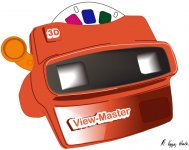Let us know how the "shoot out" goes.
Brock
Hi Brock and folks
After asking to a friend of mine for a "binoculars borrow" he gently sent me his 10x42 SE Nikon for a little performance test against my EDG II 10x42mm.
According some previous information I got here in BF (based on the SE's serial number) these 10x42 SE its the one those with the latest updated coating version.
My first impression when I first handled they was that they are very well made, nothing in these resemble a cheap binoculars, they were very friendly on hands.
I am not trying to do a "deep technical test" even because I am not used with this kind of test, its just to share my personal impressions (that can vary for sure from other members) about these two Nikon premium binoculars.
I tried both day and night for a while and then I have now something "short" to share with some EDG's / SE's owners and also (mainly) with some looking for some comparison between both:
WEIGHT / SHAPE - Both weighs "approximately" the same EDG = 790 grams SE = 710 grams -, they are both very well balanced but I think the SE is much better to handhold due their large shape which helps a lot to get a steady view under any situation and I found they less tiresome to my arms, EDG is fine but a bit heavy (I mean a bit of concentrated weight) in comparison because they are small (slim) on hands, I am used to prefer the PORRO shape ever (a personal preference however).
MECHANICS - both are very well builted (with a strong and precise construction), both carry I believe some of the best material available nowadays and apart a better eyecups system (much better in the EDG II to be precise), tripod socket and it waterproof benefit I have no one serious complaint about the SE's overall, for its price they are a very good option instead the expensive EDG II.
FOCUSER WHEEL - The SE have a nice smooth and well damped focuser, the focus wheel works even in all of it course and in both directions, not worse than the EDG but it is a bit stiff in comparison, under a hot climate (as I am here now) I see no problem at all, but I don't know how it would works under a cold climate in comparison - the EDG anyway is super smooth in both directions but still with a good amount of a damping resistance, the SE focuser is slow in comparison which I think as better for some distant subjects as the stars, airplanes, landscapes - the EDG brings the focal point a bit fast and then is a bit easy to accidentally pass of the focal point - I think the EDG speed is something as 2X faster than the SE speed - with the SE I can find the focal point and turn the wheel further for about 1/8 without loss the image sharpness while with the EDG is just a turn of 1/16 but the EDG speed it is better on the other hand when watching birds changing their position all the time among the branches. I think the EDG's dioptric adjustment a bit uncomfortable/complicated in comparison.
COATING COLOR / REFLEXION - The EDG's objective coating is deep green and the SE's objective coating is purple - both eyepiece's coating are deep green/purple - in a single test reflexion the SE's objectives coating shines less.
COLOR BIAS - I found both similar at first glance, but looking carefully through them several times I can tell now that the EDG is neutral while SE is slightly warm in comparison but not by much.
IPD ADJUSTMENT / EYE POSITION - I think the EDG II its a bit sensitive to a correct eye position than the SE - I mean, to get a perfect eye connection with the optical axis - nothing dramatic but there is some advantage to the SE.
SHARPNESS - I tried their sharpness under several situations at the daytime, nighttime, watching the Moon etc and while the SE is pretty sharp was obvious that the EDG is still a bit sharper, stars were tiny and tight in EDG than with the SE, the Moon's features were better distinguished through the EDG, I read some distant car plates and they were sharper and clear image through the EDG, maybe the absence of CA thanks to the extra ED optical element helps a lot here. There is not a huge gap between them but definitly is possible to notice it there.
BRIGHTNESS - According the Allbinos website the EDG 10x42 transmission is about 88,5% (+/-3%) and the SE 10x42 95% (+/-3%) and how the SE have less optical elements than the EDG then I was expecting to see some "visible" advantage and under the daylight I think the SE has really "a hair" (and nothing more than this) of color vividness (better contrast?) over the EDG in day time use but this may be only a personal impression since under the night sky I got a different story - I was able to distinguish better some faint stars with the EDG than with the SE, in both they were there and "hardly" visible there but no doubt easy to see when looking directly to them through the EDG, the sky bottom be a tad dark in EDG (better contrast?) and the stars are a little tight and blinking a bit less in EDG - maybe what I saw was a better resolution/sharpness due the extra EDG's ED optical element. It's hard to explain just using words but the SE while having a clear and clean image (transparency) the EDG is a step beyond...for some reason The EDG seem the "clearest" but not actually the "brightest".
CHROMATIC ABERRATION - I am particularly sensitive to CA then I can tell for sure that in a general daytime use the EDG is quite absent of any trace (or at least 95% if being extremely critical under ANY CONDITION on axis), the SE is also really very good in that regard since is necessary to look too carefully to find some but almost none is visible in a regular use - UNDER A HARD TEST - I tried both on a tree branch and also on a street electrical pole's "wire clamps" far for about 90 feet with the sunlight almost behind them (an extremely bright sky background) and there was a real advantage to the EDG that's really show no one trace of CA on axis (just a little trace of CA at the border but not intrusive) while I could see easily some CA on axis with the SE around the wire clamps and branches - I also tried both on some TV antenna against the blue sky and I could not detect it with the EDG but there were some tiny color fringes with the SE (on axis but hard to see) - for a regular use the SE works very very well and the EDG I can say they are almost perfect, wonderful performance for a Roof.
DEEP OF FIELD - I was unable to distinguish any significant difference between both.
STRAIGHT LIGHT/ INTERNAL REFLEXIONS - In both the internal reflexions are very well controlled, I recall for example as worse is the FMT-SX in comparison (by memory) I tried both (SE and EDG II) watching some street lights, the Moon, tried both mainly at the sunset and altough the SE showed just a small amount of glare and internal reflexions (in a very critical position close to the maximum sun light in the sky) the EDG II showed much less to almost none - when watching the Moon and some street lights I could see some ghost reflexions in both depending on the eye position but they were less evident anyway through the EDG II.
FIELD OF VIEW: The SE's 60 AFOV is flat and very well corrected - if you don't have no other binoculars at it side with a large AFOV I doubt this will be an issue, under de day time I found it very good and well illuminated not giving that kind of tunel vision - but at night I noticed there a very discreet vignetting over the field stop but nothing really bad or intrusive. Watching the night sky the stars remain sharp almost to the edge and this is a very positive thing - changing to the EDG however I felt a good difference - the entire AFOV is perceptibly wider and fully illuminated and also very well corrected (both seem similar in this regard) and the field stop is quite clean and clear with no one trace of vignetting over it - the EDG's 65 AFOV is really better to watch the night sky.
RELAXING VIEWS - Both are very good, very well collimated and easy to eyes but I found the EDG's views a hair comfortable, maybe due it large AFOV and it seems less prone to some blackouts.
MAGNIFICATION / OPTICAL ILUSION - Altough both are 10X the EDG II gave me sometimes an impression (when looking at some closest subjects mainly) to a very slightly large scale - but I know for sure that this is just a pure optical ilusion.
BLACKOUTS - I have a "more or less" flat set of eyes than I was worried about getting some blackouts with the SE (as experienced with the Fujinon FMT-SX 10x50) but I was surprised that I got much less with these than with the FMT-SX, actually I have not experienced no one serious blackout issue with the SE
CLOSE FOCUS - No doubt the EDG is the best here - I found the SE uncomfortable to use even at 9 mts (+ or - 30 feet) not impossible for many users for sure but not just as natural as the EDG is due their large objective angular separation (SE) which can cause some strong eyestrain.
Well, these were my impressions, they may vary from some owners here for sure but I know anyway by myself now that the EDG II is really a better binocular in some respects as CA control, large AFOV, waterprofness, slightly better sharpness, etc - but I need to admit too that the SE costing almost 3X less are very very close in optical performance.
To someone looking for an excellent binoculars at the best price these SEs deserve a serious consideration, they deserve his designation "Superior E" because they are really a "premium binoculars" with a non premium price.
I hope I make myself clear in my descriptions since I have some difficulties to express my things correctly in English, then sorry for my mistakes.
regards Pedro






